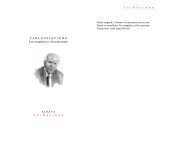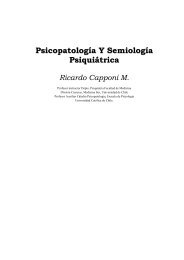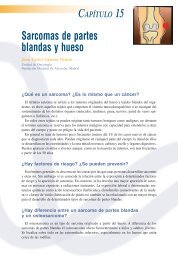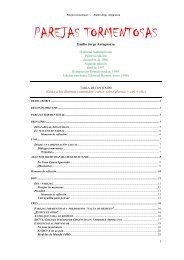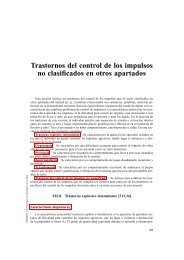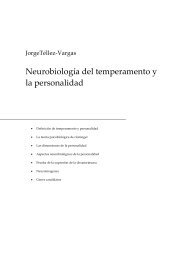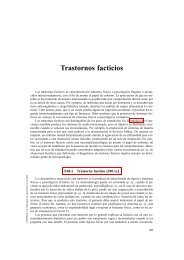Descarga
Descarga
Descarga
Create successful ePaper yourself
Turn your PDF publications into a flip-book with our unique Google optimized e-Paper software.
FUNDAP | ex - IAEPD 62<br />
| PERSONA<br />
physical pain “more bearable than emotional pain” (contained in EPs).<br />
In more complex dissociative cases, some punishing EPs may be involved in the<br />
acts of self-harm with the goal to punish other parts, for instance, they consider these<br />
parts to be guilty of the abuse (because their submissive response), as experienced in<br />
reactivated traumatic memories, or to be weak (hostile parts consider that to be strong<br />
is the only way for not being abused anymore). The punishing EPs may also express<br />
themselves as intrusive thoughts or voices that blame or threaten the ANP or another<br />
EP. Borderline patients may resort to self-harm with different levels of planning, ranging<br />
from highly impulsive to carefully planned actions. Furthermore, in some cases<br />
ANP is completely present and aware of these actions. In other cases, one or more EPs<br />
may have taken over executive control to such a degree that ANP’s presence is completely<br />
inhibited, with the result that ANP has amnesia for the triggers, the intention<br />
and planning to self-harm and/or the act of self-harm itself. It is possible that an<br />
observing part (EP) simultaneously watches from a distance what is being done.<br />
6. Affective instability due to a marked reactivity of mood (e.g., intense<br />
episodic dysphoria, irritability, or anxiety usually lasting a few hours and<br />
only rarely more than a few days)<br />
Borderline patients present an affective instability that has an effect on many areas<br />
of their life and can be manifested by abrupt changes in emotional states. Many of<br />
these patients are characterized by chronic dysphoria and feelings of emptiness. They<br />
are easily triggered by ordinary events that remind them of traumatic experiences or<br />
unresolved conflicts. Then their tendency toward feeling empty and “flat” may be<br />
interrupted by episodes of rage, anguish and desperation, in which various EPs are<br />
highly present. It is important to keep in mind that apparently ordinary events, that<br />
can actually function as “triggers” because of their perceived similarities with the original<br />
traumatizing events, may reactivate traumatic memories and EPs to which these<br />
memories belong. This can generate shifts between ANP and EP that explain many of<br />
the dramatic mood changes (Steele, 2008; Mosquera & Gonzalez, 2009a; Mosquera,<br />
Gonzalez, & Van der Hart, 2010).<br />
For example, a female borderline patient can oscillate between thinking that her<br />
partner is maltreating her (while feeling hurt or rage) and being certain she “cannot<br />
live without him” when faced with the menace of being alone. This patient can manifest<br />
very rapid and intense changes in her affect, reacting in diverse ways that both<br />
she and other find confusing. When she perceives that her partner is mistreating her,<br />
she can be re-experiencing a past aggression by her father in childhood, with a mixture<br />
of rage (fight-based EP) and fear (flight-based EP). When she shifts to the belief “I<br />
cannot live without him,” she may be shifting to a submissive EP or an attachment crybased<br />
EP. In secondary structural dissociation, these EPs are not very complex and<br />
their first-person perspective is not well-developed. The patient as ANP may be aware<br />
of these changes; when, for example, she is in touch with the child EP that feels “I cannot<br />
believe without him”, she may experience the fight EP’s enraged reaction as “not<br />
me”.<br />
Borderline patients are known for their “black and white” thinking. These extremes<br />
are characteristic of structural dissociation of the personality, with different dissociative<br />
parts having polarized perceptions, thoughts, emotions, and behavioral actions.<br />
When they feel disheartened, they can react with rage and direct their feelings towards<br />
others (for example with verbal assaults) or towards themselves (cutting, burning).<br />
Emotion dysregulation is another factor that needs to be considered related with<br />
this symptom cluster. People with a background of early chronic traumatization,<br />
attachment trauma or attachment disturbances have difficulties maintaining their<br />
emotions within a window of tolerance (Ogden & Minton, 2000; Ogden, Minton, &<br />
Pain, 2006). They can become uncontrollably hyperaroused or hypoaroused.<br />
Emotional dysregulation can be partially inheritable (Goldsmith & Harman, 1994), but<br />
this trait will be either amplified by an inadequate caregiver or moderated by a safe<br />
and supportive caregiver. During traumatizing experiences, EPs may become hyperaroused<br />
(rage, extreme fear, panic) or hypoaroused (total submission), manifesting<br />
these respective conditions whenever they are reactivated. When the caretaker is<br />
unable to regulate the child’s extreme experiences or even is the cause of them, these<br />
dissociative parts become all the more rigid and entrenched.



